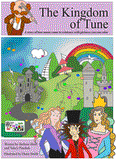Preparatory B (from 3 to 5). Lesson 38
Previous Lesson Next Lesson
To all lessons

Your FREE Demo version is here
Your full version access is here
Let's continue to learn more about the Hiner Method of music appreciation course and its unique features.
Especially important for children of the digital age is the ability to empathize with others, the ability to be human with respect to their own kind and to the world, nature, and the universe.
How "pop music" and "pop culture" inhibit the development of our children?
Pop music takes root in the consciousness of our children even before their birth, even when parents do everything possible to avoid it.

The primitiveness and repetition of musical constructions in the endlessly changing kaleidoscope of a video sequence is what the child most often encounters even when watching children’s productions or fairy tales.
In music videos, this is especially obvious.
Pop music now fills the air wherever a person appears. The clogging of the musical space with primitive musical vibrations hampers the development of the child’s thinking and litters his intellectual space.
Modern digital technologies exacerbate the picture: the aimless interaction with the "tablets" and smartphones of children of primary school age interfere with their spiritual and mental comprehension of the world. Children are exposed to the drugs of the digital world: "chronophages" -- time eaters.
Instead of healthy interaction with the surrounding real world, the child receives an overload of information. He or she is not able to comprehend, understand and digest an avalanche of incoherent images. Following very short pictures, the child’s consciousness does not have time to process one thought, as he is offered another, a contrasting and also intriguing one.
A picture, color, symbol, sound has long been used as a means of influencing a person’s subconscious.
The biggest problem in the " clip consciousness" is the impossibility to trace the beginning, development and outcome of the development of any thought or idea. The impossibility of combining puzzle pieces into a single picture turns a child into a helpless consumer of information.
Pop music does not contribute to the development of the thinking process in the way that classical music does. It is aggressively repetitive and simplified. Essentially, a motive, image or symbol sticks in the mind and is imposed on the child.
The physiological, hypnotic effect of such music on the consciousness of a child deprives him or her of the ability to distinguish low vibrations from high, spiritual from physiological, good from evil.
...
...
1. We continue to read and color the book "Kingdom Of Tune"
2. Learning to match chords to melodies using the program  Gentle Piano®
Gentle Piano®
"On The Top"
Album Solfeggio Chords 1 Major C
1. Listen to the piece on S
2. Play your left hand on L1 or L3
3. Press LH and try to find a chord to the melody by heart
4. Record the result
Video example of a student's work:
...
 If your child is developing faster or slower than our plans suggest, we recommend writing to us at admin@softmozart.com to start working with our certified specialists.
If your child is developing faster or slower than our plans suggest, we recommend writing to us at admin@softmozart.com to start working with our certified specialists.
1. Nursery 1 - "Lazy Mary"- try to play the piece with minimum mistakes and time lag. Write the results down.
2. Music Sight-Reading: ТEASER - Strauss "Radetzky's March" : Play R3, L3, P3
....
Listen to the "Radetzky March" in piano performance:
...
Visit our Soft Mozart forum and start your progress diary here. Use the current year section. This is the place for you to ask questions and share your experiences.
At least 2 photos and 1-2 videos of the listed activities will count towards your child's credits for the graduation DIPLOMA. Please upload the video to You Tube, copy the address from the BROWSER window and paste it into your Progress Diary. Do not forget to indicate the year and type of work in the description of your Soft Mozart Academy photo / video.
Sincerely Yours,
Hellene Hiner

Video success:
 Would you like to receive lessons by email weekly? Subscribe to the e-mail lesson here:
Would you like to receive lessons by email weekly? Subscribe to the e-mail lesson here:
All the lesson plans:
For 2+ students
For students from 3 to 5
For students 5+
Always check here, if we have any recital! You and your child will benefit a lot from participating in our concerts!
Your place to start your progress diary is here.


